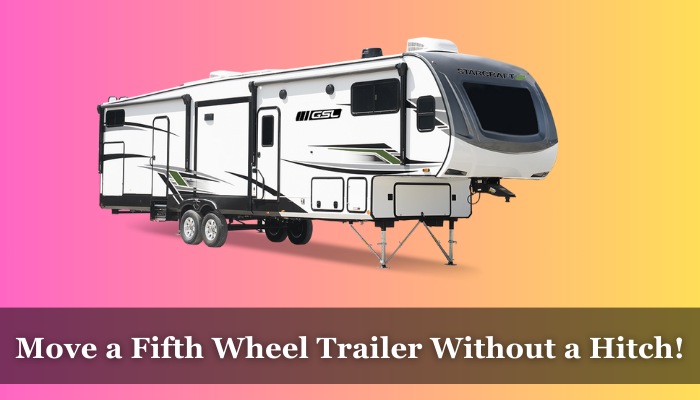This post may contain affiliate links which means I may receive a small commission for purchases made through the links. Learn More
I know every outdoor enthusiast comes across a situation where he has to move the fifth-wheel trailer without a hitch, such as if the hitch is damaged or not readily available. So, it is possible to move the trailer without the hitch, or if it is possible then how?
Yes, it is possible to move a 5th-wheel trailer without a hitch. This can be done using a tow dolly or a flatbed trailer. Using the tow dolly is probably the easiest way that will help you move your fifth wheel hitch and reach the destination. However, if the tow dolly is not available then loading the 5th wheel trailer onto the flatbed can be effective for moving the trailer without hitch.
Driving the trailer to its destination requires care and caution, as the trailer may be more difficult to maneuver without a hitch. I’ve got a lot more information to share. Let’s get started.
Related Article: How to Pull a Gooseneck Trailer With a Bumper Hitch?
Introduction to Fifth Wheel Trailers
A fifth-wheel trailer is a type of RV that attaches to a pickup truck with a special hitch in the bed of the truck. The hitch is located over the rear axle of the truck and the trailer sits over the bed of the truck, which gives the trailer more stability and reduces the risk of swaying while driving.
The main difference between a fifth-wheel trailer and other types of trailers is the way it attaches to the vehicle. Fifth-wheel trailers typically have more living space which makes them very popular among travelers. Outdoor enthusiasts can travel by having all the amenities in one place.
Typically, fifth-wheel trailers are larger and heavier than other types of trailers. They can range in size from 20 feet to 40 feet and can weigh anywhere from 6,000 pounds to 15,000 pounds. This means that moving a fifth-wheel trailer without a hitch requires a larger vehicle and is more difficult as well.
Preparing for the Move
Moving the 5th-wheel trailers is hard when you don’t have a hitch. So, a lot of extra care, and caution has to be followed. First of all, make sure that your trailer is ready to move. This includes checking the brakes, tires, lights, and hitch connections to make sure everything is in good working order.
You will also need to choose the right vehicle equipment for the move. A flatbed truck or a larger SUV with a tow package is recommended for moving a fifth-wheel trailer. A dolly or a tow bar can also be used to move the trailer, but you will need to make sure your vehicle is equipped to handle the weight of the trailer.
It’s also important to plan your route before you start moving the trailer. Make sure you know the width and height of the trailer so you can plan your route accordingly. Avoid tight spaces and corners as much as possible, and make sure you have a spotter to assist with the move.
Also Read: How to Lift a 5th Wheel Hitch Out of a Truck?
Steps to Move a Fifth-Wheel Trailer Without a Hitch
I hope that you’ve now understood the fifth-wheel trailer and are ready to go into more detail. In the section below, I’ll take you to the few steps that will help you to move the fifth-wheel trailer without a hitch. Let’s go down to a more advanced explanation.
Step 1 – Ensure the trailer is properly secured
Before moving the trailer, you need to make sure it is secure. Block the wheels and level the trailer using leveling blocks or jacks. This will prevent the trailer from rolling or shifting during the move. Make sure that the trailer is properly secured and balanced.
Step 2 – Obtain the necessary equipment
You will need a tow dolly or a flatbed trailer to move the fifth-wheel trailer without a hitch. A tow dolly is a small trailer with two wheels that are attached to a vehicle’s hitch and used to transport another vehicle. A flatbed trailer is a larger trailer with a flat deck that can be used to transport a variety of loads.
Both dolly and flatbed trailers have advantages and it is totally up to your personal needs and preferences. Below are some of the advantages of dolly;
- Smaller and lighter in size
- Easier to maneuver and store
- Cheaper than a flatbed trailer
- Does not require a special license to operate
Likewise, there are some goods of using flatbed trailers which are listed below;
- Can carry heavier loads and more vehicles
- More versatile, it can be used to transport other items besides vehicles
- Offers more stability and security for the transported vehicle.
I love dollies because they are easy to use and a bit more practical. In case you don’t have a tow dolly, then going with a flatbed and loading the 5th-wheel trailer on it is the way to go.
Step 3 – Disconnect utilities
Before you begin moving the trailer, you need to disconnect all utilities, such as the power, water, and sewer lines. This will prevent damage to the utilities and the trailer during the move.
Step 4 – Place the trailer on the tow dolly or flatbed trailer
Once the trailer is secured and the utilities are disconnected, it’s time to place the trailer on the tow dolly or flatbed trailer. If using a tow dolly, carefully drive the trailer onto the dolly and secure it in place. Below is the method of using tow dollies.
- Position the dolly or tow bar under the front of the trailer.
- Make sure the dolly or tow bar is securely attached to the trailer.
- Slowly back up your vehicle until the dolly or tow bar is pulled tight.
- Check to ensure the trailer is secure and balanced with a tow dolly.
If you have decided to use a flatbed trailer, you will need to use a winch or ramps to load the trailer onto the flatbed.
Step 5 – Drive the trailer to its destination
Finally, you can drive the trailer to its destination, following all state and federal regulations for towing. It is important to drive slowly and carefully. Keep in mind that when you move the trailer without hitch, then it becomes very difficult to control or maneuver the trailer.
In conclusion, moving a fifth-wheel trailer without a hitch requires some planning and preparation, but it can be done safely with the right equipment and approach. By following these five steps, you can move your trailer without incurring any damage or putting yourself or others in danger.
Safety Precautions that You Should Follow
Moving a fifth-wheel trailer without a hitch can be risky, so it’s important to take safety precautions to prevent accidents. If you ignore the precautions as written below, the chances will be high that you will face serious consequences.
- Always check the brakes, tires, lights, and hitch connections on the trailer before moving the trailer without the hitch.
- Slowly start driving forward, making sure to avoid tight spaces and corners.
- Make sure the vehicle towing the trailer is equipped to handle the weight of the trailer.
- It’s also important to follow all local and state regulations when moving a fifth-wheel trailer without a hitch. Some states may have specific laws and regulations that must be followed when moving a trailer without a hitch.
Other ways to move the Fifth Wheel Trailer Without a Hitch
In this above section, I’ve given you two ways that can help you move the fifth-wheel trailer without the hitch. But what if you don’t have a tow dolly or flatbed truck? The question is valid: how will you move your trailer without the flatbed truck or tow dolly?
So, I’m going to give a few more options so that if you don’t have the above-mentioned tools, you’ll still be able to move your trailer.
- Use a truck from any colleague to move the trailer
- Use the services of dealers who will help you reach the destination
- Hire a truck to move your trailer and it will cost you around 40 to 50 bucks.
Frequently Asked Questions
A flatbed truck or a larger SUV with a tow package is recommended for moving a fifth-wheel trailer without a hitch. The vehicle must be able to handle the weight of the trailer and be equipped with the necessary equipment, such as a dolly or tow bar.
The potential risks and hazards of moving a fifth-wheel trailer without a hitch include the trailer becoming unstable and swaying, the trailer becoming detached from the vehicle, and the vehicle not being able to handle the weight of the trailer.
Conclusion
Moving a fifth-wheel trailer without a hitch is possible, but you’ll have to take extra care as when you don’t use a hitch, then chances are high that the trailer will sway around and you won’t be able to control it. However, drive slowly, and use a flatbed truck or tow dolly to get things done. I hope that this guide will be useful for you. Always keep in mind that planning and preparation are key to a successful move. Happy traveling!

I’m Ahmad – the owner of this website and the writer of this post. I’ve spent 15 years in the automotive industry, especially among the hitches. What you’re reading is the experience of my 15 years.

